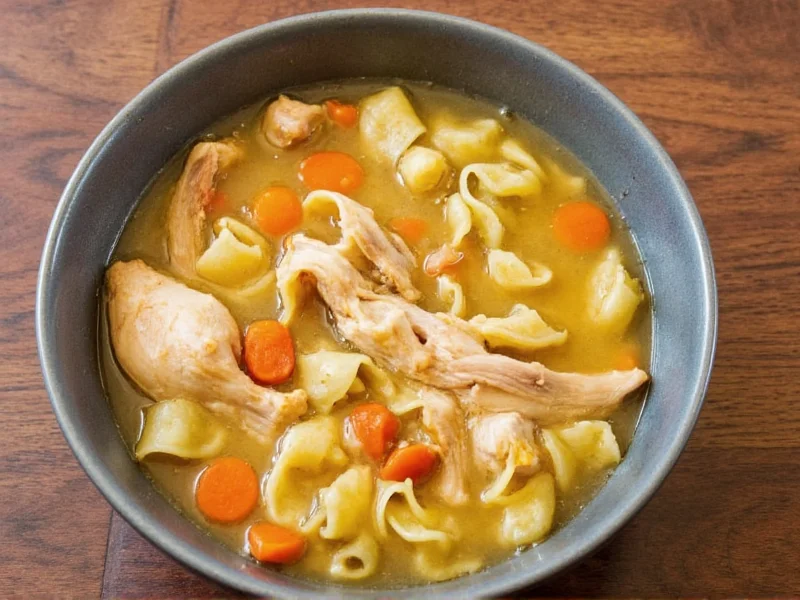Making chicken noodle soup from a carcass transforms what would otherwise be discarded into a nourishing meal. This traditional cooking technique has been used for generations across cultures, from Jewish golden soup to Chinese gut soup. When you simmer a chicken carcass properly, you extract valuable nutrients and create a broth with superior texture and depth of flavor compared to broth made from raw bones alone.
Why Carcass Makes Superior Broth
The magic happens during the initial cooking of the whole chicken. Roasting or boiling the chicken first renders fat and develops complex Maillard reaction compounds that infuse the bones with rich flavor. The carcass contains:
- Collagen-rich connective tissues that convert to gelatin during simmering
- Residual meat particles that add body to the broth
- Mineral-dense bones that release calcium and magnesium
- Naturally occurring gelatin that gives the soup its characteristic silky texture
Professional chefs often prefer using previously cooked carcasses because the initial cooking process concentrates flavors that raw bones lack. This method also represents smart kitchen economics—transforming what would be trash into a valuable culinary resource.
Step-by-Step Carcass Soup Preparation
Follow this professional technique for optimal results when making chicken noodle soup from carcass remnants:
- Prepare the carcass: Remove large pieces of meat (reserve for later) and discard any visibly spoiled parts. Rinse bones under cold water.
- Enhance flavor: For deeper flavor, roast bones at 400°F (200°C) for 20 minutes until golden brown.
- Simmer gently: Place bones in large pot with 12 cups cold water, 1 chopped onion, 2 celery stalks, 2 carrots, and 2 smashed garlic cloves.
- Add acid: Include 2 tablespoons apple cider vinegar to help extract minerals from bones.
- Low and slow: Simmer uncovered for 3-4 hours (never boil vigorously).
- Strain carefully: Remove bones and vegetables through fine-mesh sieve.
- Skim fat: Chill broth briefly, then remove solidified fat from surface.
- Final soup: Return defatted broth to heat, add reserved meat, fresh egg noodles, and seasonings.
Essential Carcass Soup Recipe
This detailed chicken carcass noodle soup recipe yields 8 servings of deeply flavorful soup:
| Ingredient | Measurement | Preparation Notes |
|---|---|---|
| Chicken carcass | 1 (from 4-5 lb chicken) | Remove large meat pieces first |
| Cold water | 12 cups | Use filtered for best flavor |
| Apple cider vinegar | 2 tbsp | Essential for mineral extraction |
| Yellow onion | 1, quartered | Leave skin on for color |
| Carrots | 2, chopped | Add during last hour of simmering |
| Celery | 2 stalks, chopped | Add during last hour of simmering |
| Egg noodles | 8 oz | Cook separately to prevent mushiness |
Troubleshooting Common Issues
Even experienced cooks encounter challenges when making soup from a chicken carcass. Here's how to solve frequent problems:
- Cloudy broth: Caused by boiling too vigorously. Solution: Start with cold water and maintain gentle simmer—never rapid boil.
- Weak flavor: Insufficient cooking time or too much water. Solution: Reduce broth by simmering uncovered for additional 30-60 minutes.
- Bitter taste: Overcooked vegetables or burnt bones. Solution: Remove vegetables after 1 hour; avoid browning bones too darkly.
- Excessive fat: Not properly chilled and skimmed. Solution: Refrigerate broth overnight before final soup preparation.
- Mushy noodles: Cooked directly in broth. Solution: Cook noodles separately and add to individual bowls.
Storage and Usage Recommendations
Proper storage maximizes the shelf life and versatility of your homemade chicken noodle soup from carcass:
- Refrigeration: Store in airtight containers for up to 5 days. The gelatin will cause broth to set like jelly when cold.
- Freezing: Portion into 2-cup containers or ice cube trays (for concentrated broth cubes) for up to 6 months.
- Reheating: Warm gently over medium-low heat. Avoid boiling to preserve delicate flavors.
- Culinary uses: Beyond traditional soup, use this broth as base for risotto, gravy, or cooking grains.
When stored properly, your homemade chicken carcass broth becomes a kitchen staple that elevates countless dishes while providing nutritional benefits unmatched by commercial alternatives. The collagen content supports joint health, while the amino acids aid digestion—making this economical soup both delicious and health-promoting.
Frequently Asked Questions
How long can I keep a chicken carcass before making soup?
Refrigerate the carcass within 2 hours of cooking the chicken and use within 3-4 days. For longer storage, freeze the carcass immediately after removing meat—properly wrapped, it will maintain quality for 4-6 months.
Can I use a rotisserie chicken carcass for soup?
Yes, rotisserie chicken carcasses work exceptionally well for soup. The roasting process develops deep flavors in the bones. Just be aware that store-bought rotisserie chickens often contain added sodium, so adjust additional salt accordingly when making your soup.
Why does my carcass broth gel when cold?
This gelation indicates a successful extraction of collagen from the bones and connective tissues, which converts to gelatin during cooking. High-quality bone broth should set like jelly when refrigerated—it's a sign of proper technique and nutrient density. The gel will liquefy again when reheated.
How many times can I reuse a chicken carcass for broth?
A chicken carcass can typically be used for one full batch of rich broth. A second simmering will yield a much weaker broth with minimal flavor or nutrients. For economical cooking, it's better to make one large batch of high-quality broth rather than stretching the same bones across multiple batches.
Is chicken carcass soup safe if I skip the vinegar?
The soup remains safe without vinegar, but you'll miss important benefits. The acid helps extract calcium and other minerals from the bones, increasing nutritional value. If you dislike vinegar's taste, use lemon juice instead—it provides the necessary acidity without lingering flavor in the finished broth.











 浙公网安备
33010002000092号
浙公网安备
33010002000092号 浙B2-20120091-4
浙B2-20120091-4